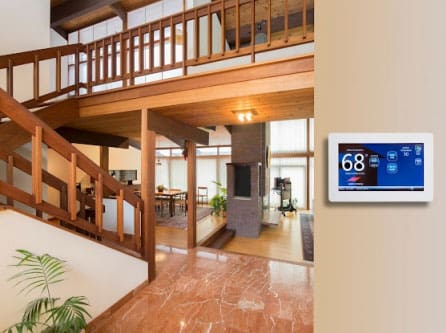The thermostat plays a big role in keeping your house warm. The thermostat stops and starts the heating process and helps to maintain the relevant temperatures. Thus, you might struggle with the following heating problems if something is not right with your thermostat.
Insufficient or No Heating
Lack of heat or inadequate heating has multiple causes. Some of them stem from thermostat problems. Below are some of these thermostat problems.
Poor Settings
The thermostat is the furnace’s input – the furnace operates according to the inputs it receives from the furnace. Thus, your furnace won’t heat your house if you don’t input the correct settings in the thermostat. For example, your house will remain cold if someone accidentally bumps the switch off, sets a low temperature, or uses the wrong program for the season.
Poor Placement
The thermostat reads the ambient temperature and calls for heat only if the ambient temperature is lower than the thermostat setting. Unfortunately, the thermostat’s placement can make it read the wrong temperature. For example, the thermostat’s reading might be higher than the house temperature if:
- Direct sunlight falls on the thermostat; for example, if you place it near an open window
- A heating appliance, such as cooking appliances, heats the area around the thermostat
In such cases, the thermostat will not call for heat, and your house will remain cold.
Dirt Accumulation
The internal parts of the thermostat, such as the contacts, need to be clean for the thermostat to read the correct temperature. Dirt, debris, and grime can cover these parts after years of use. The dirt will insulate the thermostat and prevent efficient heat transfer. The thermostat will behave as if the ambient temperature is low and won’t call for heat if that happens.
Connections
The thermostat has multiple wire connections, including those that supply it with power and those that send electrical signals to the furnace’s main control board. The thermostat can malfunction if any of these wires disconnect. For example, the thermostat’s signals won’t reach the control board if the relevant wires disconnect.
Batteries
Thermostats need electrical power to operate. Some thermostats get their power from the mains, while others use batteries. Battery-powered thermostats lose all their operations if the batteries die.
Temperature Swings
Your furnace should maintain a stable temperature in the house. Extreme temperature swings mean something is wrong, and that might be the thermostat. For example, modern thermostats use a heat anticipator to determine the exact point the furnace burners switch off.
A maladjusted heat anticipator can cause the thermostat to have erratic readings. The thermostat may call for heat only to switch off the next minute if it has such erratic readings. The result will be constant temperature swings.
Continuous Run
Lastly, a thermostat can also cause the furnace to run continually without cycling on and off. Here are some issues that can trigger continuous furnace runs.
Improper Settings
Your furnace might run continuously if you set the temperature too high. The thermostat will allow the furnace to run continuously to maintain the set thermostat. You might notice that your house is warmer than usual if that is the case.
Poor Placement
The thermostat will allow the furnace to run continuously if its temperature reading is lower than the house temperature. For example, a continuous run is possible if you place the thermostat in the path of a cold draft from outside the house.
You can solve many thermostat problems without replacing it, but replacement is sometimes necessary. Contact Steele Brothers Heating, Inc. if you suspect a thermostat problem or any other issue with your HVAC system. You can rely on our professionalism and experience to diagnose and fix the issue.

